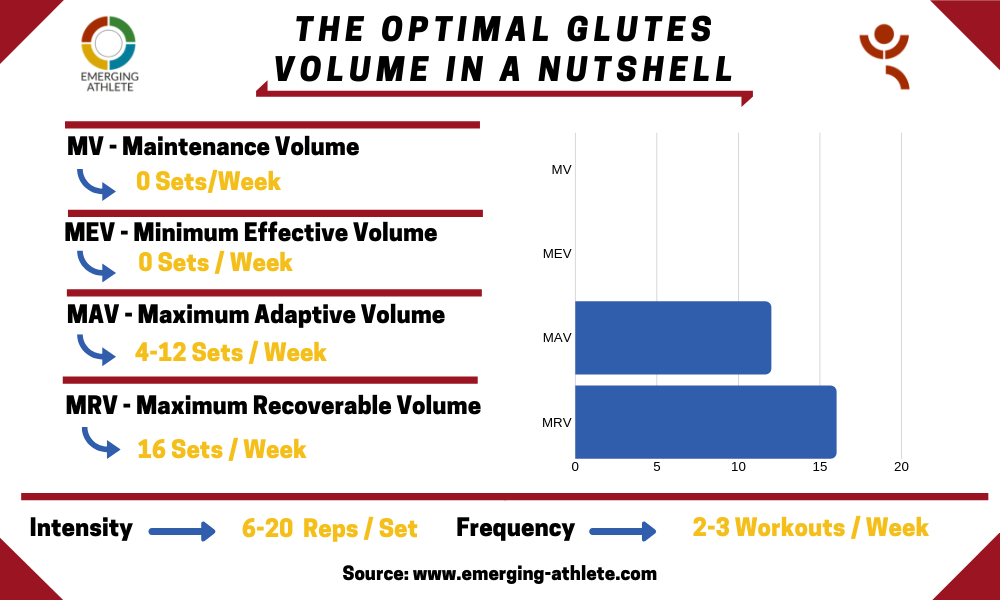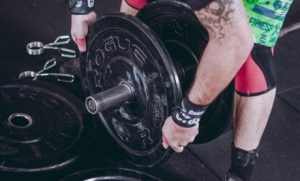Back with another hypertrophy guide and getting closer to the end of our volume series, today’s topic is not only beloved by men, but also women pay way more attention to a crisp backside than most guys might think.
Yes, you’re right, today’s article is going to be all about the optimal glutes volume.
For most men, training glutes seems unnecessary. That’s for women, right?
So should we focus more on our glutes?
Do strong glutes benefit us?
And if so, what’s the best approach to develop them?
Whether these are only some of your questions or you solely strive for tighter bottoms, I recommend you give this article a read.
Before we get started with volume recommendations, let’s take a short look at the anatomy of the glutes.

Anatomy of the Glutes
Gluteus medius
To put it in simple terms, the gluteus medius moves from the top of your pelvis down to your thigh.
Function:
Well, there is mainly one major function for the gluteus medius.
- Moving and stabilizing the hip joint.
If you want to read deeper into the glutes medius, click here for an article from Kenhub.
Gluteus maximus
With regard to the anatomical fixation points, it’s reasonably complicated to put this in a nutshell. I’ll try to keep it as comprehensible as possible.
So, basically, the muscles move from your iliac crest (area at the front and outside of the hip bones of your pelvic belt), sacral bone (bone at the base of the spine) and tailbone (a small bone at the bottom of the spine) to your thighs outside.
Functions:
The gluteus maximus functions are diverse.
- External rotation
- Abduction
- Adduction
- Hip extension
- Hip stabilization of the supporting leg while walking
Because I am not a specialist for glutes anatomy I’ll keep it as simple as possible for reasons of convenience for both of us.
Nevertheless, if you want to know more in detail about the gluteus maximus muscle, its anatomy, and functions, more information can be found here in another Kenhub article.
Gluteus minimus
The exact Latin terms are not of immense importance for you, but what you should know is that the muscle moves from your iliac scoop (the uppermost and largest part of the hip bone) to your thighs outside.
Functions:
In total, six functions can be identified for the gluteus minimus.
- Internal rotation of the hip
- External rotation of the hip
- Flexion of the hip
- Extension of the hip
- Abduction of the thigh
- Stabilization of the hip in one-legged position
For more information about the gluteus minimus, click here to view yet another article from Kenhub.
Now that we have a better clue what the glute muscles do and where exactly they’re located, the questions arise:
Does exercising glutes pay off the hassle?
Benefits of Strong Glutes
1. Better posture
Especially nowadays as most individuals are used to sit almost all day every day, it’s substantial to walk, stretch and strengthen the opposing hip flexors.
This will not only improve your body posture but might also reduce back pain.
For instance, squats, deadlifts, and lunges are exercises that you can integrate into your training routine.
They will help to strengthen your glutes, as well as properly stretch your hip.
2. Pain reduction and injury prevention
Strong glutes support the lower back.
If you have poorly developed glutes, in fact, they are too weak to perform their hip extension function.
Problem with that is, other muscles need to take over the job despite that they are not designed for that job. Eventually, this can result in overstressed muscles and pain.
So all in all, strong glutes protect your hips, knee, and ankles.
3. Improved Athletic Performance
What if I tell you that the gluteus maximus is one of the strongest muscle of the human body?
Yes, I’m not joking, guys.
At first glance, this might sound confusing, but it is true.
This means, with strong glutes performance in various sports-specific areas like speed, acceleration, distance, and endurance can benefit enormously from regular glutes workout.
Moreover, there are two other benefits, but these ones are more general and not glutes specific.
1. Increased Bone Density
The older we get, the old and damaged bones are dismantled faster than the body is capable of forming new bones.
This is a general fact that weighted training does increase bone density and does not particularly correlate with glutes.
Even though it is not particularly attributed to our glutes, over time it is even more important to work out. keeping your body physically fit benefits the human body in unbelievable many ways.
2. Increased fat loss
Similarly, the same principle applies here.
The more muscles your body consists of, the more calories do your body consumes.
Having said this, it’s again not particularly aligned to glutes but weight training overall.
If these aspects seem interesting to you and make you want to know more about it, you can find a whole article here by Inspiyr.
Now after we’ve answered some questions and took a look at the anatomy of the glutes, let’s get to work and dive into the optimal glutes volume.

MV – Maintenance Volume
What does MV mean?
MV refers to Maintenance Volume which indicates the amount of work that is required to maintain your muscle’s current size.
In other words, the amount of volume required to avoid your muscles to start shrinking.
Why is it important to know your MV?
If you have to take a break from training, you don’t want to lose your hard acquired gains, do you?
Likewise, after a period of heavy workouts in between your MAV and MRV or even above, it is for sure a good thing or even indispensable to lower your volume every once in a while.
This will desensitize your body and make it responsive for new stimuli anew.
Such phases after heavy training where you lower the volume, are so-called “deload” phases.
They often occur after 4-5 weeks of your mesocycle.
On average, you reduce your weights about 40-50% and train with the same amount of sets but within higher rep ranges.
As a result, your body can recover and when starting your new mesocycle, you’re in charge of full strength.
Either way, you need to change exercises over time to stimulate new incentives.
For beginners, stick to every 2-3 mesocycles, advanced athletes can interchange exercises every mesocycle.
Concluding, it is crucial to know what the MV is and what values to use as benchmarks to ensure maintenance during busy times.
Also, something notably important that gets underestimated a lot, is keeping the volume in your “deload phase” appropriate.
Some folks tend to train “too heavy” in their deload week. I find myself in the same situation, for sure, but for best results and enhanced performance, we need to stick to it.
If you still have questions about deloads, I recommend reading the full free guide that I wrote. Just check the previous highlighted link.
Where about is the MV for the optimal glutes volume?
MV: 0 sets/week
Here’s the deal.
With normal leg training, particularly squats, leg press, and similar quad and hamstring exercises, glutes get already stimulated quite well.
To that end, the Maintenance Volume for glutes is around 0 direct (! = isolation) sets/week for most individuals.
It can be different for you because everybody is unique and has other circumstances.
These are only average figures which are likely to work for most people, so don’t take them as fixed, immutable values.
Use them as benchmarks from where to start your program and work your way up to your optimal volume.
MEV – Minimum Effective Volume
What does MEV mean?
Minimum Effective Volume relates to the least amount of work that is necessary to stimulate at least some muscle growth.
Why is it important to know your MEV?
Briefly speaking, just like it’s important to know how much volume your glutes need to maintain its current size, it is at least of similar importance to know how much volume is required to grow your glutes, right?
What’s the minimum amount of volume that is required to get bigger and stronger glutes?
MEV: 0 sets/week
Similarly to the glutes MV value.
If your regular training program includes hell a lot of quad exercises like squats, leg press or hack squats, you get enough glute stimulation to grow.
If you look at powerlifters, most of them don’t target their glutes isolated but still have massive, jacked backsides.
Not as big as they could be, but relatively big without any direct focus.
Accordingly, if you don’t want to maximize your booty as much as possible, you will be fine with 0 sets of direct work/week.
MAV – Maximum Adaptive Volume
What does MAV mean?
MAV relates to the Maximum Adaptive Volume.
This reveals the amount of work where probably most of the muscle growth happens.
Why is it important to know your MAV?
We need to put more effort into our workout and increase the volume consistently over time if we aim for maximum outcomes.
Hence, it is important to have knowledge of the MAV.
So what’s the MAV range?
MAV: 4-12 sets/week
If you want to prioritize glutes and add size, try to start with 4 sets/week and adjust up to 12 sets/week for the MAV.
Be aware! This takes only direct work into account, more precisely isolation exercises or exercises that demand at least 2/3 of the targeted muscle.
Therefore, start low and work your way up while assessing progress in the meantime.
MRV – Maximum Recoverable Volume
What does MRV mean?
Maximum Recoverable Volume, which refers to the maximum amount of work that your body is able to fully recover.
In other words, the maximum amount of work that your body can sustain without heavy losses in strength and performance.
Sooner or later in the middle of your mesocycle program, a point will occur where progress isn’t going as smooth as it used to and your performance starts to stagnate or even decrease.
Well, this is an indication that you most likely overreached your MRV.
Why is it important to know your MRV?
Considering all the above-mentioned aspects, it is relatively logical.
Who wants to take superfluous breaks from training?
I suppose nobody wants that.
So all things considered, it’s important to know what and where your MRV is to avoid redundant breaks and overreaching at all.
What’s the maximum recoverable volume for glutes?
MRV: 16 sets/week
This does seem quite a lot, doesn’t it?
Glutes are really big and strong. Taking damage quite well.
Therefore, the higher the ability to withstand resistance, it is possible to with higher volume.
However, this does not include leg training. Squats and all other exercises do involve glutes but do not count as direct work.
In conclusion, it seems that most people can sustain up to 16 sets/week of isolation glutes work.
Frequency
How often can glutes be exercised for the optimal glutes volume?
2-3 workouts/week
Most people can train their glutes more than once a week since glutes do recover pretty well and fast compared to other muscles.
Despite all that, the key point to remember is that glutes are pretty big and strong. In general, the bigger and stronger a certain muscle is, the heavier the workload can and should be.
Thus, it takes a lot of effort to train them. If you want to train glutes more than 2-3 times/week, you have to ask yourself if you want to limit your training intensity and frequency just to train them more often.
In summary, for most individuals, 2-3 glute workouts/week work well. How often you should train them absolutely depends on your goals.
Do you want to maximize your glutes, or solely maintain them?
Adjust frequency and intensity according to your goals.
Intensity
How intense should glutes be trained for the optimal glutes volume?
6-20 reps/set
Glutes are partly designed for running. They are compound of a high percentage of fast-twitch muscle fibres which is a good reason to go as low as 6 reps/set.
In general, between 6-20 tends to be a good range that combines both the use of heavy and lighter weights.
There is something for everyone.
Glutes workout – Exercises
What exercises are best for glutes?
- Sumo squats (different squat variations)
- Lunges (dumbbell/barbell)
- Deadlifts (different variations)
- Glute Bridges
- Abductor leg raises (different variations)
- Leg press
There are many more exercises, particularly isolating but most of them are machines.
All exercises listed above are heavier compounds that you presumably have seen or heard of before. If not, give it try and see what works best for you.
Range of Motion
If you could only keep one thing in mind regarding the range of motion, then it would be to never question if you should do half or a full range of motion.
Range of motion is always a big deal, for some muscles more for others less.
But as a rule of thumb, if you execute exercises with a full range of motion, it will almost always come along with better results.
Conclusion
After we’ve gone through a lot of theory, here is what you should remember for the optimal glutes volume.

Exercises: Squats, deadlifts, lunges, leg press, abductor’s leg raises, glute bridges and all kind of variation of these exercises can be integrated into your routine.
There is no such thing as the best exercise. They all have their very own right to exist, so I suggest you implement them into your program one by one and evaluate what does suit your body best.
Range of Motion: Always strive for a full and deep stretch. For example, when doing glute bridges this is the moment your glutes begin to burn like hell. Once you notice that feeling you can be sure you’re on the right side (don’t confuse a deep burn from the stretch with pain).
If you feel pain stop it and adjust the execution for reasons of safety.
Practical Tips
For glutes, there are not really specific techniques that have proven to be very helpful.
Of course, you can still integrate some supersets or drop sets into your program from time to time, that is optional.
Lastly, as always special shout-out and credit to Dr. Mike Israetel. We really do value his knowledge and the content that he shares with us on his YT channel and his blog.
Definitely check out his video about glutes volume!
How often do you train glutes?
Guys, thanks for reading and see you next time!
Cheers,
Claas





2 thoughts on “The Optimal Glutes Volume – Hypertrophy Guide”
Thanks for sharing these guides.
You are very welcome, Lynn!